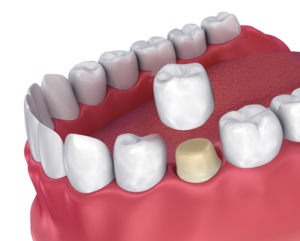Dental crowns are commonly used to protect and strengthen teeth that have been damaged or decayed. They act like a cap that covers the visible part of the tooth, providing a barrier against further damage. However, many people wonder: can a tooth still rot or decay under a crown? The answer is yes, a tooth can develop decay under a crown if certain conditions are present. Understanding how this happens and what you can do about it is important for maintaining good oral health.
In this article, we’ll explore whether a tooth can rot under a crown, what happens if decay develops, how to fix it, and how to prevent it from happening in the first place.
What Happens If You Get Decay Under a Crown?
Decay under a crown can be a serious issue. While the crown itself is made from materials like porcelain, metal, or ceramic, and cannot decay, the natural tooth underneath it is still vulnerable to bacteria and plaque. If bacteria slip under the crown, they can attack the tooth, leading to decay.

If decay develops under a crown, it can cause a range of problems, including:
- Tooth sensitivity: You might feel discomfort or pain, especially when eating hot, cold, or sweet foods. This could be a sign that the tooth underneath is deteriorating.
- Infection: If the decay reaches the inner layers of the tooth, such as the pulp, it can lead to an infection. This can cause swelling, pain, and even an abscess (a pocket of pus).
- Damage to the crown: Decay can weaken the tooth to the point where it can no longer support the crown. This can cause the crown to become loose, shift, or even fall off.
If left untreated, decay under a crown can lead to more serious dental issues, including the potential need for a root canal or even extraction of the tooth.
How Do You Fix a Decayed Tooth Under a Crown?
Fixing decay under a crown depends on how severe the damage is. Your dentist will likely recommend one of the following treatments based on the condition of the tooth and the crown:
- Replacing the crown: If the decay is caught early and hasn’t caused significant damage, your dentist may remove the crown, clean the tooth, and apply a filling or other treatment. Afterward, they’ll create a new crown to place over the tooth.
- Root canal therapy: If the decay has reached the inner layers of the tooth and caused an infection, a root canal may be necessary. During a root canal, the dentist removes the infected pulp, cleans the inside of the tooth, and then seals it. A new crown is placed over the treated tooth to protect it.
- Tooth extraction: In severe cases, if the decay has significantly damaged the tooth and it cannot be saved, your dentist may recommend extracting the tooth. After extraction, you may need to explore options like dental implants or bridges to replace the missing tooth.
The key to preventing more serious issues is addressing the decay as soon as possible. Regular dental check-ups and cleanings can help catch decay early, before it becomes a major problem.
How Can You Tell If a Tooth Is Infected Under a Crown?

Detecting an infection under a crown can be tricky because the crown itself covers the tooth, making it difficult to see what’s going on underneath. However, there are some signs and symptoms that can indicate a problem:
- Pain or sensitivity: If you feel discomfort when biting down, or if you notice sensitivity to hot, cold, or sweet foods, it may be a sign that something is wrong with the tooth under your crown.
- Swelling or redness: Infection can cause the gum tissue around the crown to become swollen or red. You may also notice tenderness in the area.
- Bad taste or smell: Infections can produce a bad taste in your mouth or cause bad breath that doesn’t go away with brushing or mouthwash.
- Abscess: If an infection is severe, you may develop an abscess, which is a pocket of pus that forms around the root of the tooth. An abscess can cause significant pain, swelling, and even fever.
If you experience any of these symptoms, it’s important to see your dentist right away. Infections under crowns can spread to other parts of the mouth and even the body if not treated promptly.
Why Does Decay Occur Under a Crown?
There are several reasons why decay might develop under a crown. Understanding these causes can help you take steps to prevent it:
- Poor oral hygiene: Just because you have a crown doesn’t mean you can slack on brushing and flossing. If you don’t keep your mouth clean, plaque and bacteria can build up around the edges of the crown and slip underneath, causing decay.
- Gaps or loose crowns: If a crown doesn’t fit properly or becomes loose, it creates small gaps where bacteria can enter. Over time, this can lead to decay. It’s important to visit your dentist regularly to ensure your crown fits well and stays in place.
- Damage to the crown: Crowns can crack or become damaged from things like grinding your teeth (bruxism) or biting down on hard foods. A damaged crown may expose the tooth underneath, making it more vulnerable to decay.
- Existing decay: In some cases, decay may have already been present before the crown was placed, and if not fully treated, it can continue to spread underneath the crown.
Can You Prevent a Tooth From Decaying Under a Crown?
Yes, there are steps you can take to prevent decay under a crown. Good oral hygiene and regular dental visits are the best defense against tooth decay, even if you have crowns. Here’s what you can do:
- Brush regularly: Make sure to brush your teeth at least twice a day with fluoride toothpaste. Pay special attention to the gumline where the crown meets the tooth, as this is where plaque tends to accumulate.
- Floss daily: Flossing helps remove food particles and plaque from between your teeth and around your crown. Flossing is especially important because it reaches areas that your toothbrush can’t.
- Use an antibacterial mouthwash: Rinsing with mouthwash can help kill bacteria that lead to plaque buildup and decay.
- Visit your dentist regularly: Regular check-ups allow your dentist to monitor the condition of your crown and catch any issues early. Professional cleanings also remove plaque that you may have missed at home.
- Avoid hard or sticky foods: Chewing on hard foods like ice or popcorn kernels can crack your crown, while sticky foods like caramel can dislodge it. Being mindful of what you eat can help prolong the life of your crown and prevent decay.
How Long Do Crowns Last?

Dental crowns are designed to be durable, but they aren’t invincible. On average, a well-maintained crown can last anywhere from 10 to 15 years or longer. However, the lifespan of a crown depends on several factors, including:
- Oral hygiene: How well you take care of your teeth and gums will have a big impact on how long your crown lasts. Brushing, flossing, and regular dental check-ups are essential.
- Material: The type of material used for the crown can also affect its longevity. Porcelain crowns, for example, are known for their natural appearance, but they may not be as durable as metal crowns.
- Wear and tear: Habits like grinding your teeth (bruxism) or chewing on hard objects can wear down your crown over time, making it more susceptible to damage.
If your crown becomes damaged or starts to show signs of wear, your dentist may recommend replacing it to prevent decay and other issues.
What Should You Do If Your Crown Falls Off?
If your crown falls off, don’t panic—but don’t ignore it either. A lost crown can expose the tooth underneath, making it vulnerable to bacteria and decay. Here’s what you should do:
- Keep the crown: If your crown falls out, carefully retrieve it and bring it to your dentist. In some cases, the dentist can clean it and reattach it.
- Rinse your mouth: Gently rinse your mouth with warm water to remove any debris.
- See your dentist: Contact your dentist as soon as possible to schedule an appointment. In the meantime, avoid chewing on the side of your mouth where the crown came off, and be careful when brushing the area.
Conclusion
While crowns are a great way to protect and restore damaged teeth, it’s important to remember that the tooth underneath is still vulnerable to decay. Decay under a crown can lead to serious dental problems, including infection and tooth loss, if not treated promptly. By practicing good oral hygiene, visiting your dentist regularly, and addressing any issues with your crown as soon as they arise, you can keep both your crown and the tooth beneath it healthy for years to come.
If you suspect that you have decay or an infection under a crown, don’t wait—schedule an appointment with your dentist right away. With proper care and attention, you can avoid further complications and keep your smile looking and feeling its best.

